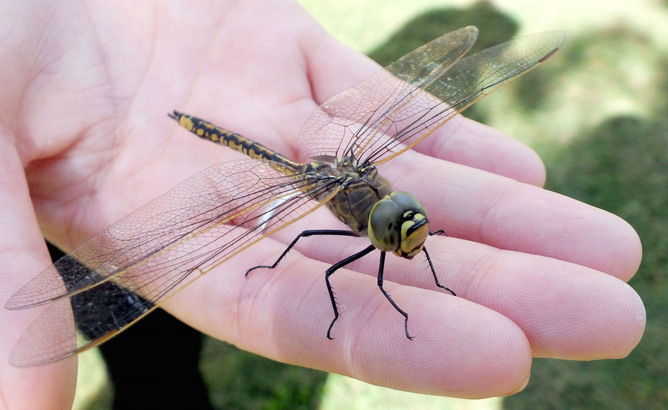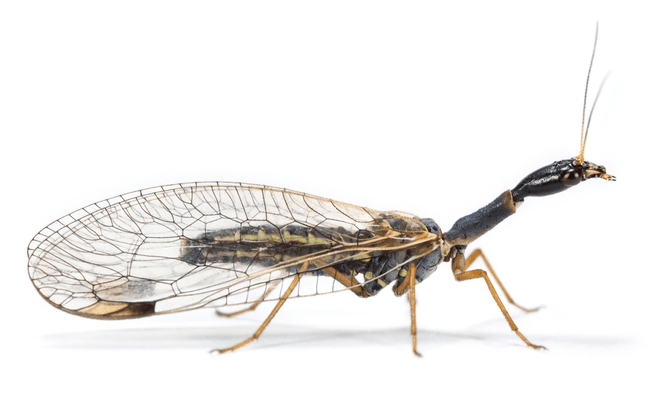By David Yeates, CSIRO
The Australian Emperor Dragonfly is only a handful compared to its ancestors who measured more than 60cm. Flickr/Daniel lightscaper, CC BY
The time and date of the origin of insects and their pattern of evolution and survival over millions of years is revealed in a new study, published today in Science magazine.
Insect relationships have always been very difficult to unravel because of the sheer diversity of insect life – one in every two multicellular organisms (animals and plants) on Earth is an insect. Another difficulty was because insects evolved so long ago.
The study, a collaboration of more than 100 scientists from 16 countries as part of the 1000 Insect Transcriptome Evolution project, looked at the evolutionary history of insects.
Not only are insects diverse, they are also of immense economic and medical importance. They affect our daily lives in both positive and negative ways, from pollinating our crops to spreading diseases such as malaria.
But we can only start to understand the enormous species richness and ecological importance of insects with a reliable reconstruction of their relationships.
It’s all in the DNA
The researchers used a DNA sequence dataset of unprecedented scale and new analysis techniques. This allowed them to look deep back in time to when insects evolved from crustaceans (crabs, lobsters and prawns) and emerged onto land between 450 million and 500 million years ago.
The research is the most recent in the emerging field of phylogenomics – the crossover between evolution and genomics. It provides a detailed view of evolution over deep time scales and over large branches of the tree of life.
Researchers sequenced all the genes from more than 140 types – such as moths, flies, wasps and beetles – and used these to calculate the relationships between all the major groups of insects.
DNA used in the search for ancestors of today’s insects such as the Cuckoo wasp (Hedychrum nobile) Oliver Niehuis, Author provided
They then compared all the gene sequences from the insects and found all the genes that were common to all species, and were directly comparable.
A major challenge of these analyses is to find the right genes to compare. Evolution tinkers with genes and modifies old genes for new functions, hence many genes are copied, and most organisms have many similar copies of genes in their DNA makeup.
After a strict selection process the researchers found 1,478 directly comparable genes for the analyses – a much larger set than had been available before for this kind of analysis.
The analysis team then integrated fossil evidence with the genetic dataset and models of molecular evolution to estimate when the different groups evolved.
That’s an old bug
The study shows that insects originated at the same time as the earliest terrestrial plants about 500 million years ago. The closest relatives of the first insects were probably similar to silverfish, modern primitive insects that have never evolved wings.
Nothing much has changed in the Silverfish (Lepisma saccharina).
Flickr/Stanislav Sedov, CC BY
The analyses suggest that insects and plants shaped the earliest terrestrial ecosystems together, with insects developing wings to fly about 400 million years ago.
This was long before any other animal could do so and occurred almost as soon as land plants developed height.
We can only speculate as to why these ancient insects adapted so quickly. Modern insects have large population sizes and extremely plastic, modular anatomy that gives them great advantages in being able to capitalise on new opportunities in the environment.
The closest modern relatives of the first winged insects are dragonflies and mayflies, and large dragonfly relatives with a wingspan of 60-70cm existed not long after insects first developed wings.
Thank goodness these large, swift general predators with slashing mandibles are not around today! Insects (and angels) are the only group of flying animals that have not given up a pair of arms or legs for wings.
Most major groups of insects appeared in a burst of evolution about 350 million years ago such as grasshoppers and cockroaches. Many common groups of insects such as flies, wasps and beetles appeared more than 200 million years ago.
A Snakefly (Dichrostigma flavipes) – note how insects didn’t give up limbs to evolve wings.
Dr Oliver Niehuis, ZFMK, Bonn, Author provided
The study confirms recent evidence that termites are just social cockroaches – cockroaches that have lost their wings, live in large colonies and have developed different body shapes (castes) within the same species for different duties in the nest.
Surviving the mass extinctions
While many other groups, such as dinosaurs, were affected by mass extinction events, insects seem to have sailed on regardless.
Because they have adapted to virtually every terrestrial environment, many insect groups survive extinctions and then diversify by quickly adapting to new situations and opportunities that appear after such biodiversity crises.
In many ways evolution is a numbers game, and the large population sizes of many insects mean that there is a good chance that favourable mutations will arise somewhere, sometime that allow insects to exploit new situations quickly.
We see this today as insects quickly develop methods to detoxify new insecticides and become resistant.
The future of insect survival
The study reinforces the great importance of understanding insect biology for the future of human kind. That insects have been on the planet for almost half a billion years and flourished is simply because they are literally everywhere and adapt quickly to new environments and opportunities.
Insects will likely feed on the last vertebrate carcass on the planet. So we would be wise to prepare for a long and arduous battle each time we compete with insects for resources.
We now have a very detailed and precise view into the genetic constitution of insects. In future it will become possible to comparatively analyse metabolic pathways of different insects and use this information to more specifically target undesirable species.
The study will enable researchers to link the ecological responses of insects to their genetic makeup in new and exciting ways.
Buoyed by the success of this study the research consortium – which includes CSIRO – is now embarking on a huge analysis of more than 2,000 insect genomes.
This will provide a more detailed evolutionary canvas and timescale, and enable the consortium to ask exactly how insects responded to the crises and opportunities that appeared during their long and successful occupation of planet Earth.
![]()
David Yeates receives funding from various Australian and International funding agencies, and holds the Schlinger endowed research position at the Australian National insect Collection.
This article was originally published on The Conversation.
Read the original article.






7th November 2014 at 1:24 pm
Fascinating article and amazing research. I tip my (virtual) hat to the dedicated study that went into this.
If I were to make a general, hopefully constructive comment about articles on evolution, I think when writing about evolution we should never miss the opportunity to remind the reader, especially non science minded folk, that an organism does not consciously evolve to survive better (eg to ‘develop wings’). Rather we should remind the reader that it is the genes that do the generational surviving. The genes mutate randomly and build a body that either survives its short time on earth, or don’t. The surviving body then provides the next ‘vessel’ in which this process might continue. All that really propagates down the ages is the ever-changing programme that makes bodies if it ends up in the right molecular soup. I think that if we don’t remind reader (and ourselves) of this often, we fall into the trap of thinking ‘aren’t they clever little blighters to have developed wings”.
I find evolution more understandable if I think of the plants and animals that exist today as ‘today’s outcrops’ of the gene programmes that are surviving best. It may sound pedantic, but given the ever-present temptation to believe a Great Designer has a hand in creating the things we see around us that we choose to call beautiful, we should be vigilant and remind ourselves that life is essentially a bunch of chemical reactions, some of which propagate better in the existing environment than others do. This doesn’t have to make it any less beautiful; beauty is what we choose.
I’m surely preaching to the converted in this forum, but it’s my take away message for kids and non scientists who happen to read this.